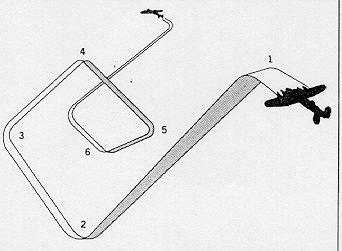
Evasive maneuvers
The RAF heavy bomber’s standard evasive maneuver enabled it to continue on course while presenting an attacking fighter with an extremely difficult target. This maneuver is performed any time the attack is from the rear to middle of the craft. The diagram at Figure 1. shows the maneuver following a port fighter attack.

Figure 1. Corkscrew maneuver
How to:
1. The pilot (originally cruising at 200-225 mph) opens his throttle and banks at 45 degrees to make a diving turn to port (because the enemy aircraft is on the port – reverse the maneuver if enemy is on starboard.); descending through 1,000 ft in six seconds, the bomber reaches a speed of nearly 300 mph. After the 1,000 ft descent, the pilot pulls the aircraft into a climb, still turning to port.
3. He reverse the turn, halfway through the climb which has caused his speed to fall sharply, possibly forcing the attacking night fighter to overshoot.
4. Regaining his original altitude, with speed down to 185 mph and still in the starboard turn, the pilot pushes the aircraft down into another dive.
5. Picking up speed in the dive, he descends through 500 ft before reversing the direction of the turn.
6. If the fighter is still on his tail, he stand by to repeat the maneuver. The physical effort required by the pilot has been compared with that of an oarsman pulling hard in a boat race.
The next question is what do we do with an attack from the front area since our turrets will not move left or right. If the attack is basically head on point the nose towards the enemy plane just like a fighter. Otherwise, use the corkscrew. It was rare that a Lancaster was attacked head on during night operations.
Another type of mutual defence tactic developed by the Americans was the ‘Thatch-weave’ mutual defence tactic. Figure 2 shows how it works.

Figure 2. Thatched-weave
The ‘Thatch-weave’ defence was adopted to allow small number of aircraft to cover each other. Tow aircraft cut across each other’s tails alternately to prevent a fighter closing in on one unawares. The practise could be extended for two pairs of bombers to interweave one behind the other alternately.